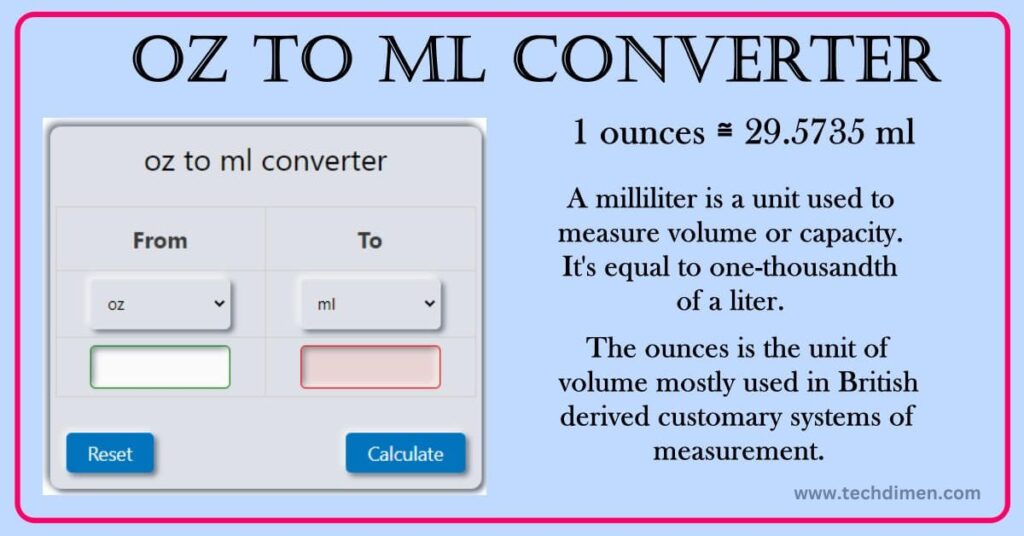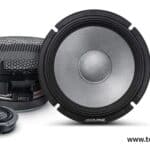When it comes to liquid measurements, particularly in cooking, health, and science, converting ounces to milliliters (oz to ml) is a fundamental skill. However, with different systems in use around the world especially in Canada, where both Imperial and Metric measurements coexist it’s easy to get confused. This guide provides everything you need to know about converting ounces to milliliters online in Canada, explaining the formula, offering examples, and helping you choose the right tools to make your conversions quick and accurate.
Why Accurate oz to ml Conversion Matters in Canada

Accurate oz to ml conversion is crucial in many areas of everyday life, particularly in Canada, where both Imperial and Metric measurement systems are used in various contexts. The importance of getting this conversion right extends beyond simply using the right tools it can affect cooking, health, scientific experiments, and even the products we use. Below, we’ll explore the reasons why oz to ml conversion is so important in Canada.
1. Accurate Measurements in Cooking and Baking
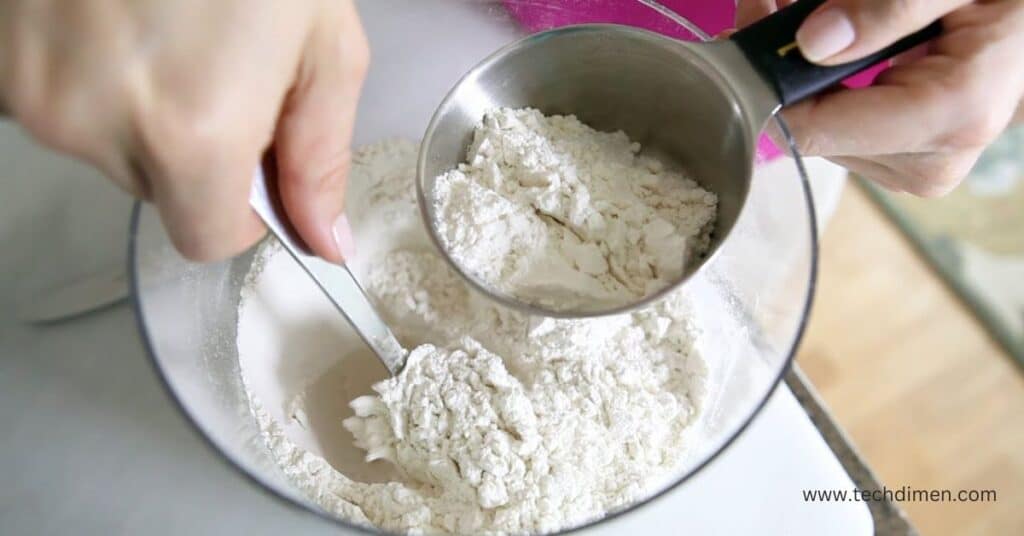
In Canada, kitchen measurements often rely on both Imperial ounces (oz) and metric milliliters (ml). Canadian recipes may call for measurements in oz, while others may use ml. Confusing the two or miscalculating the conversion can result in a ruined dish, whether you’re baking a cake, preparing a soup, or making a drink.
For example, if a recipe calls for 8 oz of milk but you mistakenly use 8 ml instead, your dish will likely have the wrong texture or taste. This is particularly common in baking, where precision is critical. An inaccurate conversion can lead to overmixing or undermixing ingredients, affecting the overall result.
2. Standardized Liquid Measurements for Medicine and Supplements
In healthcare, oz to ml conversion is essential for both prescribed medication and over-the-counter supplements. Many liquid medications, vitamins, or even herbal supplements come in bottles that use ounces on the label, especially in Canadian pharmacies. Misreading or improperly converting these measurements can lead to incorrect dosing, which could be potentially harmful.
For example, a liquid medicine dosage might recommend 1 oz (about 30 ml) per dose. If the dosage is misunderstood and 1 oz is mistaken for 1 ml, the patient could be underdosed. Similarly, if 1 oz is taken as 100 ml, the patient could be overdosed, leading to adverse effects.
3. Consistency in Beverage and Food Packaging
In Canada, packaged beverages—such as juices, sodas, and alcoholic drinks—are often labeled using ounces. Whether you’re buying a can of soda or a bottle of wine, the volume is often given in ounces (oz). Knowing how to convert those ounces into milliliters (ml) is crucial for understanding how much you’re consuming.
Alcoholic beverages are commonly sold in fl oz bottles, and many people in Canada prefer to know the equivalent amount in ml for easier comparison across different products. For instance, 12 oz of beer is equivalent to 355 ml, which is useful when you’re watching your liquid intake or checking the alcohol content of different products.
4. Ensuring Accuracy in Scientific and Laboratory Settings
In scientific research, oz to ml conversion plays a vital role, particularly in fields like chemistry, biology, and pharmacy. Laboratory measurements require precise volume measurements of liquids. If you’re conducting experiments and working with chemicals, the accurate conversion from oz to ml can affect the results of your research. For instance, a discrepancy of a few milliliters could lead to errors in reactions or inaccurate data.
Many laboratory procedures rely on exact liquid volumes in milliliters. Researchers and students working with lab equipment, from pipettes to graduated cylinders, rely heavily on the metric system, making it essential to convert from ounces when dealing with non-metric materials.
5. Health and Hydration Tracking

For those tracking their daily water intake, knowing how much water is in a fluid ounce or milliliter is crucial for staying healthy. In Canada, many water bottles and other beverages are labeled in oz. If you need to keep track of your hydration levels and you prefer the metric system, understanding the oz to ml conversion will help you manage your fluid consumption.
For instance, a 16 oz bottle of water is equal to 473.17 ml. Knowing how many milliliters of water you should drink each day (usually around 2000-2500 ml for adults) is made easier by understanding this conversion, especially if your bottle is labeled in ounces.
6. International Trade and Export
Canada’s food and beverage exports often involve international trade with countries that use both Imperial and Metric systems. When converting ounces to milliliters, especially for international trade agreements, it’s essential to use the correct conversion. A mix-up could affect the quantity of products being shipped or mislead customs authorities.
Products like cosmetics, pharmaceuticals, and packaged food that are shipped across borders need accurate measurements on their labels. Misleading consumers or import authorities with incorrect measurements can lead to legal issues or delays in shipments.
7. Reducing Confusion in Everyday Life
While Canada uses the Metric system for most measurements, certain Imperial units, like ounces, are still prevalent in certain contexts. From recipes to product labels, having a solid grasp of the oz to ml conversion eliminates confusion, ensuring that whether you’re cooking, drinking, or managing health, you can confidently measure liquids.
This is particularly important in daily life where both systems coexist. For example, the confusion can arise when someone has to convert from an Imperial recipe to Metric measurements. A misunderstanding of the correct oz to ml conversion could lead to errors and frustration in the kitchen.
The Role of Technology in Accurate oz to ml Conversion

Thanks to the advances in technology, online converters, mobile apps, and even digital kitchen scales now make it easier than ever to convert ounces to milliliters accurately. Apps like kitchen measurement tools in Canada or online oz to ml converters allow people to make these conversions in seconds, removing the guesswork. These tools can be easily accessed on smartphones, tablets, or computers.
Online Oz to Ml Converter Tools
Many people now turn to online oz to ml converters for quick and accurate results. These converters are accessible 24/7, and whether you need to convert a single ounce or a whole batch of ounces to milliliters, these tools simplify the process. Some conversion calculators even allow you to select whether you’re converting between US fluid ounces or Imperial ounces to milliliters.
Kitchen Scales with Built-in Converters
Digital kitchen scales equipped with oz to ml converters are becoming more popular in Canadian households. These scales automatically convert measurements as you weigh ingredients, ensuring that you don’t have to manually calculate the ounces to milliliters.
the Types of Ounces: US Fluid oz vs Imperial oz
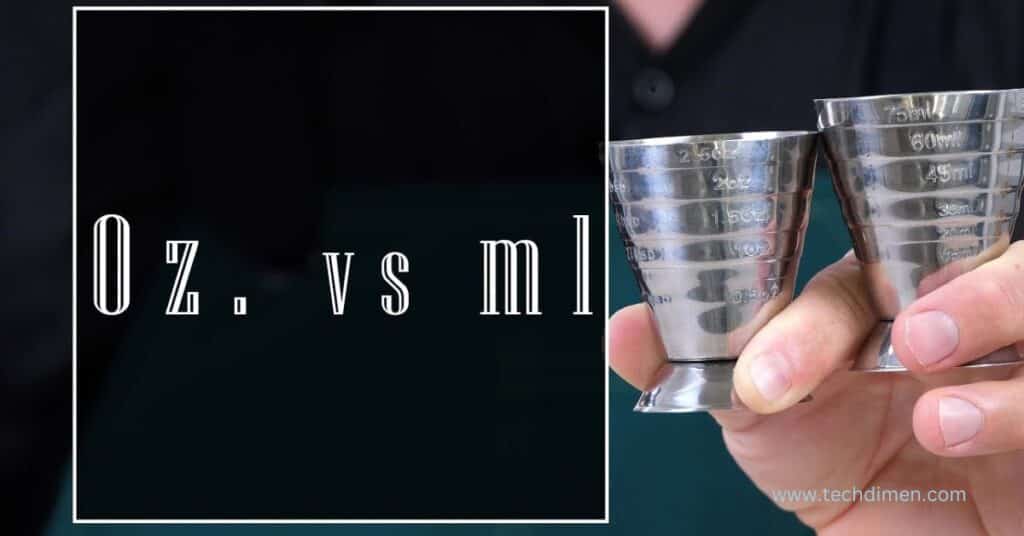
When it comes to measuring liquids, especially for those working with recipes, beverages, or even medicine, understanding the types of ounces is essential. In particular, the US fluid ounce (oz) and Imperial ounce (oz) are the two primary units of measurement that often lead to confusion. Both ounces are used to measure liquid volume, but they are not the same. Despite their similar names, the US fluid ounce and the Imperial ounce differ in volume, which can have an impact on the accuracy of measurements, especially when converting to milliliters.
What is a US Fluid Ounce?
The US fluid ounce is a unit of measurement commonly used in the United States and, to some extent, in Canada for certain product labeling. A US fluid ounce is defined as 1/128th of a US gallon or about 29.5735 milliliters (ml). This means that a US fluid ounce is slightly smaller than its Imperial counterpart.
The US fluid ounce is primarily used to measure liquids and beverages, such as milk, juice, water, and alcoholic drinks. In the food and beverage industry, this measurement is most commonly used for packaging. For instance, soft drinks and bottled beverages in the US are often labeled in fluid ounces.
What is an Imperial Ounce?
The Imperial ounce, on the other hand, is used primarily in the UK, and while it’s less common in Canada, it still appears in some contexts, especially when dealing with historical recipes or certain imported goods. The Imperial ounce is defined as 1/160th of an Imperial gallon, and it is equivalent to about 28.4131 milliliters (ml).
Historically, the Imperial system was developed in the UK and has influenced the measurement systems in several countries, including Canada. The Imperial ounce is typically used for measuring liquids, including alcoholic beverages like beer and wine, as well as cosmetic products, especially those imported from the UK.
Key Differences Between US Fluid Ounce and Imperial Ounce
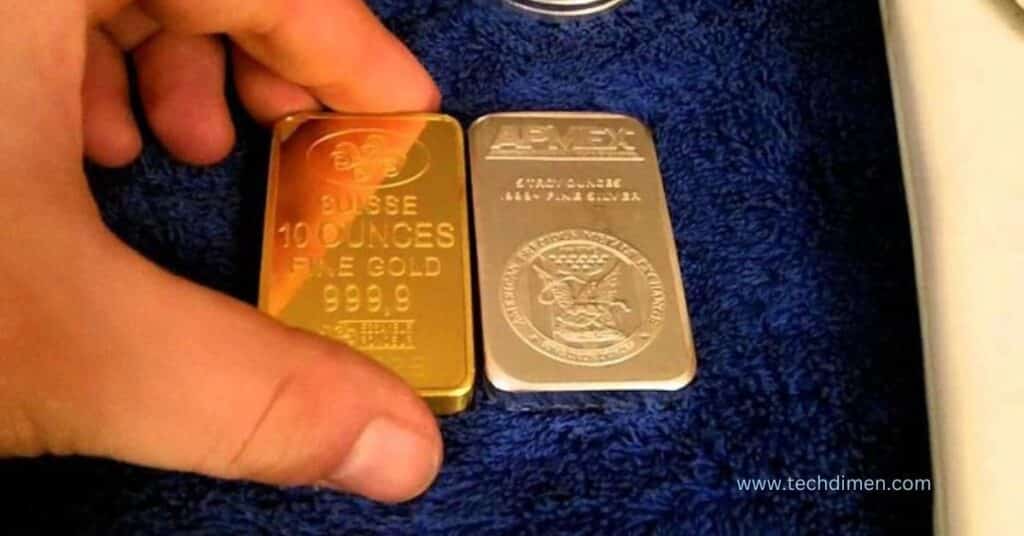
The key difference between the US fluid ounce and the Imperial ounce lies in their volume:
- US fluid ounce: 1 US fluid ounce = 29.5735 ml
- Imperial ounce: 1 Imperial ounce = 28.4131 ml
Although the difference might seem minor, it can be significant when working with small measurements, particularly in baking or medicine. A slight error in conversion can change the outcome of a recipe or a medication dosage, which can have serious consequences.
Why the Difference Matters
While the difference of roughly 1.16 milliliters between the two ounces may not seem like much at first glance, it can be impactful in certain applications. This discrepancy can cause problems for those who need to be precise with measurements, especially when using international recipes or dealing with products that use different measuring systems.
For example, if you’re making a recipe that calls for 4 oz of liquid and you mistakenly use US fluid ounces when it requires Imperial ounces, you could end up with an extra 4.64 ml in your dish. While it might not ruin every dish, this difference can affect the taste, texture, or consistency, especially in baking where precision is key.
The same can happen when dealing with medicine. If a liquid medication is meant to be taken in Imperial ounces and you mistakenly measure in US fluid ounces, you might unintentionally overdose or underdose, which can be dangerous.
Why Both Systems Are Still in Use Today
Both the US fluid ounce and Imperial ounce are still widely used, and understanding their difference is crucial, particularly for Canadians. Even though Canada officially uses the metric system, both Imperial ounces and US fluid ounces appear in various contexts, such as on product labels, recipes, and even health-related instructions.
For instance, a recipe from an American cookbook may use US fluid ounces, while a Canadian recipe could use Imperial ounces. Additionally, many liquid medications in Canada use US fluid ounces or are listed in milliliters, requiring the consumer to know the difference to accurately measure the dose.
Common Scenarios Where the Difference Matters

There are several real-world scenarios where the difference between US fluid ounces and Imperial ounces might matter:
- Cooking and Baking: Many recipes, especially those from the United States, will provide measurements in US fluid ounces, while Canadian or UK-based recipes may use Imperial ounces. Getting the conversion wrong can lead to too much or too little of an ingredient, resulting in incorrect flavors, textures, or outcomes.
- Beverages: Bottled beverages like sodas, water, or alcohol might display volumes in fluid ounces, either US fluid ounces or Imperial ounces. Knowing which system applies helps when buying these drinks or preparing beverages at home, especially for recipes or specific portion sizes.
- Health and Medication: Liquid medications or vitamins are often sold in fluid ounces in the US, but the packaging may differ in Canada, where milliliters may be used alongside US fluid ounces. An accurate understanding of these measurements can prevent dangerous dosing errors.
- Beauty and Cosmetic Products: Many beauty products, such as shampoo or perfume, use fluid ounces as a unit of measure, but some imported products may be listed in Imperial ounces, while others use US fluid ounces. Converting these measurements ensures you’re using the correct amount.
How to Convert Between US Fluid Ounces and Imperial Ounces
If you encounter a situation where you need to convert between the US fluid ounce and the Imperial ounce, it’s important to have the proper conversion factor:
- 1 US fluid ounce = 29.5735 ml
- 1 Imperial ounce = 28.4131 ml
To convert US fluid ounces to Imperial ounces, you can use the following formula:
US fluid ounces × (28.4131 / 29.5735) = Imperial ounces
Conversely, to convert Imperial ounces to US fluid ounces, you can use:
Imperial ounces × (29.5735 / 28.4131) = US fluid ounces
It’s important to note that these conversion formulas are crucial when dealing with liquid measurements for cooking, health, and international trade.
What is a Milliliter (ml)?
A milliliter (ml) is a metric unit of volume commonly used to measure liquids and other substances in smaller quantities. It’s a part of the metric system, which is the standard for measurements in most countries, including Canada. Milliliters are widely used in various fields, including cooking, health care, and scientific research, due to their precise and manageable volume.
Definition and Size of a Milliliter
The milliliter is defined as 1/1000th of a liter (L), meaning that 1 liter equals 1,000 milliliters. In terms of volume, 1 milliliter is equivalent to 1 cubic centimeter (cm³).
To give you a clearer sense of scale:
- 1 milliliter (ml) = 0.001 liter (L)
- 1 milliliter (ml) = 1 cubic centimeter (cm³)
This small measurement unit is perfect for situations where precision is necessary, such as measuring liquids, medicine, or even ingredients in cooking.
Milliliters in Everyday Life
Milliliters are used in numerous everyday activities, from the kitchen to the medical field. Here are some common examples of how milliliters are applied in daily life:
- Cooking and Recipes:
In the kitchen, recipes often call for ingredients in milliliters to ensure precise proportions. For example, a recipe might require 250 ml of milk, which is the equivalent of 1 cup. Using milliliters allows cooks to follow instructions accurately, especially in international recipes where different measurement systems are used. - Beverages:
When purchasing drinks, liquid volumes are often displayed in milliliters. A 500 ml bottle of water, or a 355 ml can of soda, are common examples. For beverages that are served in bars or restaurants, the volume might be expressed in milliliters, especially when dealing with small servings like a shot of liquor (often 30 ml). - Medicine and Health:
In healthcare, medication doses are often prescribed in milliliters. For example, a liquid medicine might be recommended as 5 ml per dose. Measuring liquid medicine accurately is crucial to avoid under- or overdosing, making milliliters a highly reliable and precise unit in medical prescriptions. - Beauty and Personal Care:
Many cosmetic products, like shampoos, perfumes, and lotions, are also measured in milliliters. For instance, a bottle of 50 ml of perfume is a common size. Knowing the exact milliliter volume can help consumers gauge how much product they’re purchasing and how long it will last.
Why Milliliters Matter
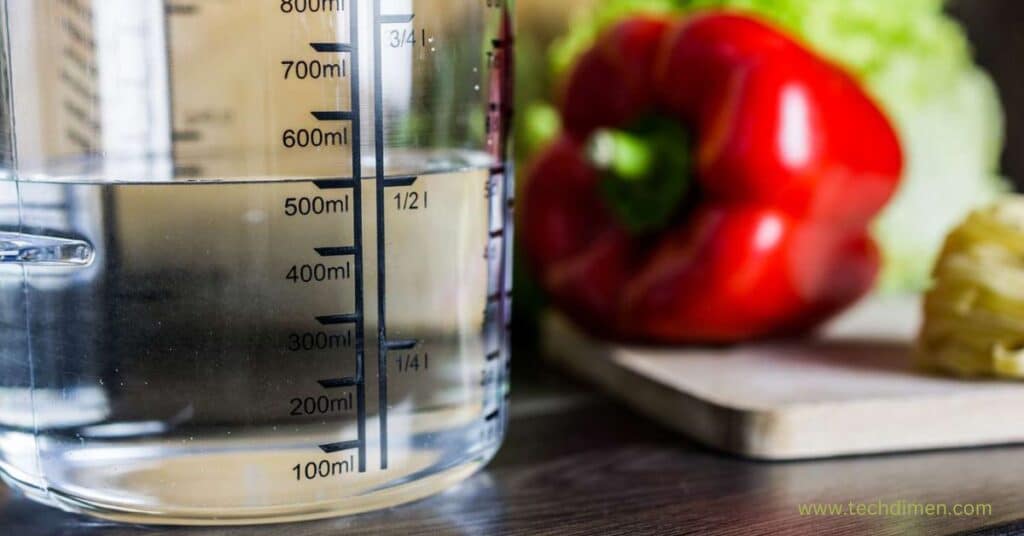
The use of milliliters allows for accurate and consistent measurements, particularly when dealing with liquids. Unlike other volume measurements, milliliters are easier to handle because they offer finer control. In countries like Canada, where the metric system is used, milliliters provide a standard and universal method for liquid measurement.
For example, when you’re mixing a medicine dose, it’s crucial to be precise. If a doctor prescribes 10 ml of a liquid medicine, getting the correct volume is critical. A small mistake could lead to either insufficient medication or an overdose.
In cooking, milliliters allow for accurate ingredient measurements, ensuring consistent results. While a tablespoon or cup measurement may work for larger quantities, milliliters are useful when small adjustments are needed. Whether you’re baking or making a cocktail, using the exact amount of liquid in milliliters guarantees the outcome you want.
The Role of Milliliters in the Metric System
Milliliters are part of the metric system, which is the system of measurement used worldwide, except in a few countries that use the Imperial system. The metric system is based on powers of 10, which makes conversions between units like milliliters, liters, and kiloliters very easy. For example:
- 1 liter (L) = 1000 milliliters (ml)
- 10 milliliters (ml) = 0.01 liters (L)
- 100 milliliters (ml) = 0.1 liter (L)
Because of this easy-to-follow structure, milliliters offer a high level of consistency and accuracy, making them a go-to unit for everyday measurements, especially when precision is crucial.
Milliliters vs. Ounces: Understanding the Difference
While milliliters are used universally as part of the metric system, ounces (oz) are part of the Imperial system. This can cause confusion when converting between the two systems, especially in recipes or product labels.
For instance:
- 1 US fluid ounce = 29.5735 milliliters
- 1 Imperial ounce = 28.4131 milliliters
Thus, understanding the difference between ounces and milliliters, and being able to convert between them, is key in situations where both systems are used, like in Canada where both metric and Imperial units are found in various contexts.
How to Convert Milliliters to Ounces
When you need to convert milliliters (ml) into ounces (oz), you can use these conversion factors:
- 1 milliliter (ml) = 0.033814 US fluid ounces (oz)
- 1 milliliter (ml) = 0.035195 Imperial ounces (oz)
To convert from milliliters to ounces, simply multiply the milliliters by the respective conversion factor. For example, if you want to convert 100 ml to ounces, you would do the following:
- 100 ml × 0.033814 = 3.3814 US fluid ounces
- 100 ml × 0.035195 = 3.5195 Imperial ounces
How is Milliliter Used in Canada?
In Canada, the milliliter (ml) is a widely used unit of measurement, especially for liquids and small volumes. As a member of the metric system, the milliliter is the standard unit for measuring volume, and it plays a crucial role in everyday activities, from cooking and healthcare to shopping and scientific applications. Understanding how milliliters are used in Canada helps ensure precision and consistency in daily life.
Milliliters in Cooking and Recipes
One of the most common uses of milliliters in Canada is in the kitchen. Whether you’re following a recipe for baking, cooking, or making beverages, milliliters are often the unit of choice for measuring liquids. Most Canadian recipes use milliliters to indicate the volume of ingredients like water, milk, oil, vinegar, and sauces.
For example, a recipe might ask for 200 ml of water, which is approximately 3/4 of a cup. This precision helps ensure that the recipe turns out exactly as intended. In some cases, kitchen tools like measuring cups and spoons come with milliliter markings for easy measurement.
Because milliliters are part of the metric system, they provide a straightforward way to measure smaller quantities, making them especially helpful in precise recipes like baking, where even a slight difference in liquid measurements can affect the outcome.
Milliliters in Healthcare and Medicine
In healthcare, milliliters are crucial for ensuring the correct dosage of medications and liquid supplements. Prescriptions for medicines, such as cough syrup or liquid antibiotics, are typically given in milliliters. This standard unit ensures that patients receive the exact amount prescribed, which is essential for the effectiveness of the treatment.
For instance, a doctor might prescribe 10 ml of a liquid medication to be taken three times a day. Without a clear measurement system like milliliters, overdosing or underdosing could occur, leading to potential health risks.
Additionally, healthcare professionals use syringes and other measuring instruments calibrated in milliliters to administer medications accurately. Whether it’s for children’s liquid medicine or IV fluids, the use of milliliters ensures that precise amounts are given to patients based on their condition.
Milliliters in Beverages
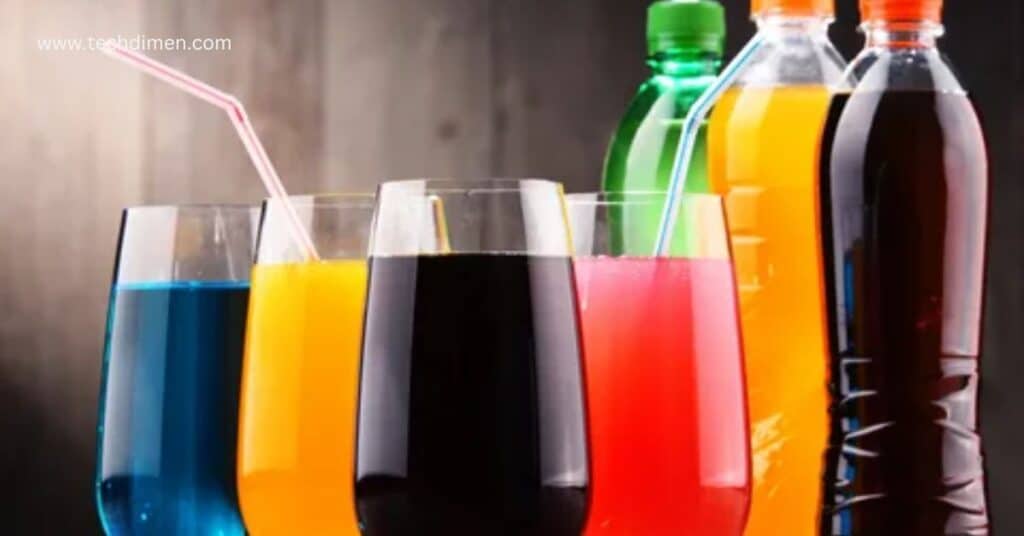
In Canada, milliliters are also the standard for measuring beverages, especially bottled drinks. Whether it’s a bottle of water, a can of soda, or a coffee cup, the volume is typically labeled in milliliters.
For example:
- A typical bottle of water in Canada might contain 500 ml.
- A can of soda is often sold in 355 ml cans.
- A cup of coffee at a café might range from 200 ml to 500 ml, depending on the size.
The use of milliliters for beverage measurements ensures that consumers are aware of how much liquid they are purchasing, enabling them to make more informed choices.
Milliliters in Personal Care Products
Another area where milliliters are commonly used in Canada is in personal care products. Items like shampoo, conditioner, lotions, perfumes, and toothpaste are often sold in bottles or tubes labeled with milliliter measurements. This is especially important for consumers who are looking to purchase the right amount for their needs.
For instance, a bottle of shampoo may contain 250 ml, while a perfume bottle might hold 50 ml. Knowing the milliliter volume helps consumers understand the value of the product in relation to its size, and it also helps in calculating how long the product will last.
Milliliters in Scientific Research and Laboratories
In scientific and laboratory settings, milliliters are used extensively for measuring liquids, chemicals, and solutions. In Canada, as in many other countries, research and experimentation require precise measurements to ensure the accuracy of results.
For example, a scientist working with chemical reactions or biological samples might need to measure out exact volumes of reagents, which are often in the range of milliliters. This is critical in fields like pharmaceutical research, environmental science, and biotechnology, where precise volumes can significantly impact the outcome of experiments.
Milliliters in Product Labels and Packaging
The Canadian Food Inspection Agency (CFIA) mandates that food and beverage products in Canada must include clear and accurate labeling, including the volume of liquids in milliliters. For packaged beverages, liquids, and liquid food products, the volume in milliliters provides consumers with the necessary information to compare products and make purchases based on the amount of liquid they are getting.
For example, a bottle of juice may indicate 750 ml, and a container of yogurt might list 500 ml. This consistency in labeling ensures that consumers know exactly what they’re purchasing, helping them make informed decisions.
Milliliters in the Imperial and Metric Systems
Canada uses the metric system for most measurements, including milliliters. However, the Imperial system is still commonly used in the United States. This can sometimes lead to confusion, especially when converting between imperial ounces (oz) and metric milliliters (ml), as the volume measurement can differ between systems.
For example, 1 US fluid ounce is equivalent to approximately 29.5735 ml, while 1 Imperial ounce is about 28.4131 ml. Understanding these differences is important when purchasing products from the US or following recipes that use US measurements.
Milliliters in Environmental and Sustainability Efforts
Milliliters also play a role in environmental efforts. Many Canadians are actively trying to reduce their environmental footprint by using reusable bottles and minimizing the use of disposable plastic bottles. By choosing products that clearly indicate their volume in milliliters, consumers can make better decisions about how much liquid they need to purchase and whether they are using eco-friendly packaging.
For example, opting for a 1-liter water bottle instead of buying smaller 500 ml bottles can help reduce waste, especially if you refill the larger bottle. Understanding milliliters can support more sustainable consumption patterns in Canada.
Converting Milliliters in Canada

Since Canada uses the metric system, converting between milliliters (ml) and liters (L) is simple. The conversion is straightforward because the metric system operates on base-10 increments:
- 1 liter (L) = 1000 milliliters (ml)
- 10 milliliters (ml) = 0.01 liter (L)
- 100 milliliters (ml) = 0.1 liter (L)
These conversions make it easy for Canadians to calculate larger or smaller amounts when needed. For example, if you’re following a recipe and need to convert 500 ml to liters, you simply divide by 1000, giving you 0.5 L.
Ounces to Milliliters Conversion Formula
To accurately convert between ounces and milliliters, it’s essential to know the correct formula based on the type of ounce.
For US fluid ounces, 1 oz = 29.5735 ml.
For Imperial ounces (used in Canada), 1 oz = 28.4131 ml.
if you want to convert 8 ounces:
- 8 oz (US) = 8 x 29.5735 = 236.588 ml
- 8 oz (Imperial) = 8 x 28.4131 = 227.305 ml
To convert oz to ml, simply multiply the number of ounces by the conversion factor.
Ounces to Milliliters Conversion Table
Here is a quick reference table to help you convert ounces to milliliters:
| Ounces (oz) | US Fluid oz (ml) | Imperial oz (ml) |
|---|---|---|
| 1 | 29.57 | 28.41 |
| 2 | 59.15 | 56.83 |
| 5 | 147.87 | 142.07 |
| 8 | 236.59 | 227.31 |
| 10 | 295.74 | 284.13 |
| 16 | 473.17 | 454.61 |
| 32 | 946.35 | 909.22 |
Real-Life oz to ml Conversion Examples
When it comes to practical usage, knowing how to convert ounces to milliliters is essential.
For instance, when baking a cake, you might need to convert oz to ml for ingredients like milk. A typical recipe might call for 8 oz of milk, which converts to:
- 8 oz (US) = 236.59 ml
- 8 oz (Imperial) = 227.31 ml
Knowing these conversions ensures that your cake turns out as expected without errors due to wrong measurements.
Similarly, if you’re looking to stay hydrated, water bottles are often labeled in ounces. A typical 16 oz water bottle equals:
- 16 oz (US) = 473.17 ml
- 16 oz (Imperial) = 454.61 ml
These examples show how understanding the oz to ml conversion helps in practical situations.
Ounces to Milliliters Converter Tools: What’s Reliable in Canada?
When you need a quick, accurate conversion, relying on online oz to ml converters is the way to go. There are various tools and apps available that help make this process seamless.
One option is the Square Yards oz to ml calculator, which is a simple and fast online tool for quick conversions. Another great option is the Canada measurement tool, which provides both Imperial and Metric conversions. Kitchen measurement tools are also popular, especially for cooks in Canada. These apps offer easy-to-read charts and calculators for fluid ounces to milliliters.
When selecting an online oz to ml converter, it’s important to choose one that clearly specifies whether it uses US or Imperial ounces. Also, ensure the tool is accurate and up-to-date with the latest measurement standards to avoid any confusion or mistakes.
Commonly Used Abbreviations for Ounces and Milliliters
Understanding the common abbreviations for ounces and milliliters will help you avoid confusion in everyday measurements.
oz stands for Ounce,
fl oz stands for Fluid Ounce (used for liquids),
ml or mL stands for Milliliter.
It’s important to note that dry ounces are different from fluid ounces, and the fluid ounce is what’s typically used for liquid measurements. This distinction is essential when dealing with conversions between oz and ml.
Ounces vs Milliliters: Key Differences
When it comes to measuring liquid volumes, ounces and milliliters are two commonly used units, but they belong to different measurement systems. Understanding the key differences between these two units is essential, especially for anyone who is involved in cooking, shopping, healthcare, or scientific research. These differences are primarily rooted in the systems of measurement each unit belongs to imperial vs metric and they affect how we measure and convert volumes in daily life.
1. Measurement System, Oz To Ml (Ounces to Milliliters)
The most fundamental difference between ounces and milliliters is the measurement system they belong to:
- Ounces are part of the imperial system, commonly used in the United States and some other countries that still use imperial measurements.
- Milliliters belong to the metric system, which is used by Canada, most of Europe, and many other countries around the world.
In Canada, the metric system is the official system for all official measurements, which is why milliliters (ml) are more commonly used in everyday life, while ounces (oz) are still often seen in recipes and product labels from the United States.
2. Unit Size and Conversion, Oz To Ml (Ounces to Milliliters)
The size of an ounce and a milliliter differ significantly:
- 1 ounce (oz), specifically the US fluid ounce, is equal to 29.5735 milliliters (ml).
- 1 imperial ounce, used in the UK and other imperial-system countries, is slightly smaller, at 28.4131 ml.
This difference in size between US and imperial ounces is one reason why converting between ounces and milliliters can be confusing, especially when dealing with international recipes, product packaging, or medications.
3. Volume vs Weight, Oz To Ml (Ounces to Milliliters)
Another key difference is how ounces are sometimes used to measure weight (dry ounces) and sometimes volume (fluid ounces), whereas milliliters are always a measure of volume:
- Fluid ounces (oz) measure liquid volume. This is the unit typically used in recipes, beverages, and liquid products.
- Ounces (oz) can also refer to weight, especially when dealing with dry ingredients (like 1 oz of flour), but this is not applicable when measuring liquids.
- Milliliters (ml), on the other hand, is strictly a volume measurement and is used exclusively for liquids and other substances that occupy space.
This distinction is especially important in contexts like cooking, where ingredients might be measured in ounces (weight) versus milliliters (volume).
4. Geographic Usage
The usage of ounces vs milliliters can vary significantly depending on where you are located:
- Ounces are widely used in the United States, where fluid ounces are the standard unit for liquid measurements in most contexts. For example, beverages and cooking recipes in the US typically use ounces for volume.
- In contrast, milliliters are the standard unit in countries that use the metric system, like Canada, most European countries, and many others around the world.
For instance, a bottle of water in Canada will usually indicate its volume in milliliters, while in the US, the same bottle might list the volume in fluid ounces.
5. Precision in Measurement
Milliliters offer a more precise measurement compared to ounces due to the nature of the metric system. The metric system is designed around base-10 increments, making it easier to calculate, convert, and understand.
For example:
- 1 liter (L) = 1000 milliliters (ml)
- 1 milliliter (ml) = 1/1000th of a liter
- 1 fluid ounce (oz) = 29.5735 milliliters
This means milliliters allow for more accurate measurements in smaller quantities, which is particularly useful in scientific experiments, cooking, and healthcare. In contrast, ounces may offer slightly less precision due to their base-16 system (part of the imperial system).
6. Common Usage and Applications
While both ounces and milliliters are widely used, their common applications vary by context:
- Milliliters are the go-to unit for liquid measurements in countries using the metric system. For example, recipes in Canada typically use milliliters to measure ingredients like milk, water, and oil. Milliliters are also used for medications, beverages, personal care products, and more.
- Ounces are frequently seen on product labels in the United States, such as for beverages, liquid medications, and cosmetic products. In addition, US fluid ounces are commonly used in recipes, especially those sourced from the US.
In Canada, while milliliters are standard, recipes, especially those influenced by American culture, often list ingredient volumes in ounces. This is why it’s important to understand how to convert ounces to milliliters accurately.
7. Converting Between Ounces and Milliliters
Converting between ounces and milliliters is simple once you know the conversion factor. However, since there are two different types of ounces, it’s crucial to choose the correct conversion factor:
- To convert US fluid ounces to milliliters:
- 1 oz (US fluid ounce) = 29.5735 ml
- 5 oz = 147.8675 ml
- To convert Imperial ounces to milliliters:
- 1 oz (Imperial fluid ounce) = 28.4131 ml
- 5 oz = 142.0655 ml
This is where an oz to ml converter or oz to ml calculator becomes a helpful tool. It eliminates the guesswork and ensures accuracy, especially when working with measurements in kitchen recipes, medicine dosages, or beverages.
8. Practical Examples of Ounces vs Milliliters
Ounces and milliliters are often used interchangeably when discussing volumes of liquid, but understanding the conversion between them is vital in many practical situations. For example:
- If you’re following an American recipe for making pancakes and it asks for 1 cup of milk, which is approximately 8 ounces, you can convert this to 240 milliliters to follow a Canadian recipe.
- If you’re taking a liquid medicine that is measured in milliliters but your bottle uses fluid ounces, you can convert the amount from oz to ml to ensure you’re taking the correct dose.
FAQs
1. How many milliliters are in 1 ounce?
In the US measurement system, 1 fluid ounce (oz) is equal to 29.5735 milliliters (ml). However, in the Imperial system (used in some countries like the UK), 1 fluid ounce is equal to 28.4131 milliliters.
2. What is the formula to convert ounces to milliliters?
To convert ounces to milliliters, use the following formula:
- For US fluid ounces:
ml = oz × 29.5735 - For Imperial fluid ounces:
ml = oz × 28.4131
This formula allows you to convert liquid measurements accurately from ounces to milliliters.
3. How many milliliters is 8 ounces?
- If you’re using US fluid ounces, 8 oz equals 236.588 milliliters.
- If you’re using Imperial fluid ounces, 8 oz equals 227.305 milliliters.
4. How do I convert fluid ounces to milliliters in Canada?
Since Canada uses the metric system, the standard conversion for fluid ounces to milliliters is as follows:
- 1 US fluid ounce = 29.5735 milliliters.
- You can use an online oz to ml converter or the oz to ml formula for quick and accurate conversions.
5. Is 30 ml equal to 1 ounce?
No, 30 milliliters is slightly more than 1 US fluid ounce. Specifically, 1 fluid ounce is approximately 29.5735 milliliters, so 30 ml is just over 1 ounce.
6. What is the difference between US fluid ounces and Imperial ounces?
The main difference between US fluid ounces and Imperial ounces lies in the amount of liquid they represent:
- 1 US fluid ounce = 29.5735 milliliters.
- 1 Imperial fluid ounce = 28.4131 milliliters.
Thus, US ounces are slightly larger than Imperial ounces, making conversions between the two systems important in some contexts.
7. How many milliliters are in 4 ounces?
- 4 US fluid ounces equals 118.294 milliliters.
- 4 Imperial fluid ounces equals 113.652 milliliters.
8. How do I use an oz to ml converter?
An oz to ml converter is a tool available online that helps you convert ounces to milliliters quickly and accurately. You simply input the number of ounces (either US or Imperial) into the converter, and it will give you the equivalent milliliters based on the correct conversion factor.
9. Why do ounces and milliliters have different values in the US and Canada?
The difference arises because the United States uses the imperial measurement system, while Canada uses the metric system. Ounces and milliliters are different units from two measurement systems, so conversions between them must be accurate, especially when working with recipes or medications across countries.
10. How can I convert 1 liter to ounces?
To convert 1 liter (1000 milliliters) to US fluid ounces, you can use this formula:
- 1 liter = 33.814 US fluid ounces. For Imperial fluid ounces, 1 liter equals 35.195 Imperial fluid ounces.
11. Are milliliters used for all liquid measurements in Canada?
Yes, milliliters (ml) are the standard unit for liquid measurements in Canada, especially for food, beverages, and health-related products. The metric system is the official system of measurement in Canada, making milliliters the primary unit for liquid volume.
12. Is 250 ml the same as 8 oz?
No, 250 milliliters is slightly more than 8 US fluid ounces. Specifically:
- 250 ml is equal to 8.453 US fluid ounces.
- 250 ml is equal to 8.799 Imperial fluid ounces.
13. What does “oz” mean in milliliters? Oz To Ml (Ounces to Milliliters)
The abbreviation “oz” stands for ounces, a unit of volume in the imperial system used in the US. The equivalent of oz in milliliters depends on whether you’re using US fluid ounces or Imperial fluid ounces:
- 1 US fluid ounce = 29.5735 ml.
- 1 Imperial fluid ounce = 28.4131 ml.
14. Can I use the same conversion for fluid ounces and dry ounces?
No, fluid ounces and dry ounces measure different things:
- Fluid ounces (oz) measure the volume of liquids.
- Dry ounces (oz) measure the weight of dry ingredients like flour, sugar, etc.
Therefore, the conversion from ounces to milliliters applies only to fluid ounces and not dry ounces.
15. How do I convert ounces to milliliters in recipes?
To convert ounces to milliliters in a recipe, use the appropriate conversion factor based on the US fluid ounce or Imperial fluid ounce:
- For US fluid ounces: Multiply the number of ounces by 29.5735.
- For Imperial fluid ounces: Multiply the number of ounces by 28.4131.
This will give you the equivalent volume in milliliters. Always check whether the recipe uses US fluid ounces or Imperial ounces before converting.
These frequently asked questions provide clarity on the differences between ounces and milliliters, how they are used, and how to convert between them. Whether you’re working in the kitchen, measuring liquid medications, or dealing with international recipes, knowing how to convert accurately is crucial.
Bonus: Printable oz to ml (Ounces to Milliliters) Conversion Chart for Kitchen Use
Having a printable oz to ml conversion chart in your kitchen can be incredibly useful when you’re cooking or baking. Whether you’re following recipes that use US fluid ounces, Imperial ounces, or working with different measurement systems, this chart will help you quickly and accurately convert between ounces (oz) and milliliters (ml).
Here’s how the chart can simplify your cooking:
Why You Need an Oz to Ml Conversion Chart
- Accurate Recipe Measurement: Different countries use different units of measurement. For example, US recipes may list ingredients in ounces, but in Canada (and many other countries), milliliters is the standard. This chart helps you convert those measurements quickly.
- Universal Application: Whether you’re measuring liquids for a beverage recipe, cooking, baking, or even health supplements, knowing the conversion between oz to ml is essential.
- Avoiding Measurement Mistakes: Inaccurate conversions can lead to failed recipes or incorrect doses for medicine. Having a reference guide ensures you get it right every time.
How to Use the Oz to Ml Conversion Chart
- Step 1: Find the number of fluid ounces (oz) listed in the recipe or label.
- Step 2: Find the corresponding milliliters (ml) value in the chart.
- Step 3: Use the measurement in ml as needed.
This chart is especially useful when you need to scale recipes or deal with different units from various countries, ensuring consistency in your results.
Printable Oz to Ml Conversion Chart
Here’s a handy oz to ml conversion chart you can print and keep in your kitchen or near your cooking area:
| Ounces (oz) | Milliliters (ml) |
|---|---|
| 1 oz | 29.57 ml |
| 2 oz | 59.14 ml |
| 3 oz | 88.71 ml |
| 4 oz | 118.29 ml |
| 5 oz | 148.76 ml |
| 6 oz | 177.83 ml |
| 7 oz | 207.40 ml |
| 8 oz | 236.59 ml |
| 9 oz | 266.16 ml |
| 10 oz | 295.74 ml |
| 15 oz | 442.11 ml |
| 20 oz | 591.47 ml |
| 25 oz | 739.83 ml |
| 30 oz | 887.20 ml |
| 40 oz | 1182.93 ml |
| 50 oz | 1478.66 ml |
Key Points to Remember
- US Fluid Ounces: The above chart is based on the US fluid ounce, where 1 oz = 29.5735 ml.
- Imperial Ounces: If you’re working with Imperial ounces, the conversion is slightly different. 1 Imperial ounce is equal to 28.4131 ml. You can adjust the chart by using that conversion factor.
- Accurate for Liquid Measurements: This chart works for converting liquid ounces (such as for beverages, oils, or cooking ingredients). If you’re working with dry ounces, the conversion may differ based on the weight of the ingredient.
How to Use the Chart for Different Purposes
- In the Kitchen: Whether you’re preparing meals or baking, you might need to convert between fluid ounces and milliliters when following a recipe. For instance, if a recipe calls for 8 oz of water, simply convert it to 236.59 ml using the chart.
- Measuring Beverages: Many beverage recipes or cocktail guides call for measurements in ounces. If you’re following a recipe that uses oz and need it in milliliters, just refer to the chart. For example, 2 oz of lemon juice equals 59.14 ml.
- Health and Supplements: Liquid medicine dosages or liquid supplements are often labeled in milliliters but sometimes require converting to ounces (oz). This chart can help ensure you measure the correct amount.
Download and Print the Oz to Ml Conversion Chart
You can easily download and print the oz to ml conversion chart from various online tools or create a custom one using the table above. This will be a perfect reference when you’re cooking or measuring liquids. Keeping a printable chart in your kitchen will save you time and reduce the chances of measurement errors.
With this oz to ml conversion chart, you’ll be well-equipped to handle any recipe or liquid measurement, whether it’s for cooking, beverages, or health-related tasks in Canada. It ensures accuracy and eliminates confusion, making your kitchen work more efficient.
Conclusion
Understanding how to convert oz to ml is essential for everyday tasks in Canada, from cooking to dosing medication and measuring beverages. Knowing which ounce you’re using, whether US fluid ounces or Imperial ounces, and applying the correct conversion formulas can save you time and frustration.
Using reliable online oz to ml converters and having a conversion table or app on hand will ensure that your measurements are always accurate, whether you’re preparing a meal or checking your hydration levels.
Now you’re equipped with the knowledge to handle any ounces to milliliters conversion in Canada. Whether you’re cooking a meal, measuring liquids, or working on a scientific project, you’ll have the tools and formulas you need to make precise conversions every time.

Jhon AJS is a tech enthusiast and author at Tech Dimen, where he explores the latest trends in technology and TV dimensions. With a passion for simplifying complex topics, Jhon aims to make tech accessible and engaging for readers of all levels.

